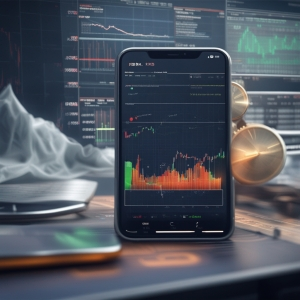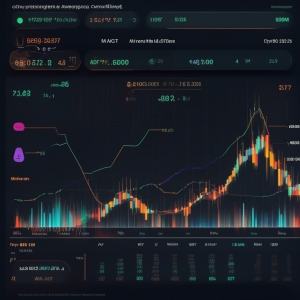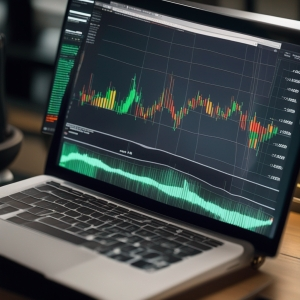Cryptocurrency trading can seem daunting for beginners, particularly due to the volatility of the market. However, shedding light on how prices move might make the process less mystifying. Today, we'll examine technical indicators, useful tools which provide insights into the future trajectory of cryptocurrency prices based on historical trading data.
Introduction: Understanding Crypto Price Movements
The price of a cryptocurrency, like any asset, is fundamentally based on supply and demand dynamics. However, these dynamics are often influenced by a variety of factors, including market sentiment, economic events, regulatory news, technological advancements, and more. Despite this complexity, several tools and methods can help us make sense of these movements. Among these methods are technical indicators, which we'll delve deeper into in this article.
Just like the weather, while we can't predict the future state of the market with 100% accuracy, understanding technical indicators can give us a sense of what the weather – or in this case, market trends – might potentially look like ahead. Mastering these tools can provide you an edge in making educated trading decisions.
What are Technical Indicators?
Technical indicators are statistical tools that traders use to interpret and predict price movement trends in financial markets. These indicators help traders to make informed decisions based on patterns and trends found in historical data. They are categorized broadly into two classes: trend indicators and oscillators.
Trend indicators, as the name suggests, help identify market trends. They provide insights into the direction of the market, showing whether a cryptocurrency is in a bullish (upward) trend or a bearish (downward) trend. The most common trend indicator is the moving average, which calculates an average for the cryptocurrency price over a specific timeframe.
Oscillators, on the other hand, are technical indicators that move within a certain range, typically between zero and one hundred. These indicators are particularly useful in identifying overbought or oversold conditions in the market, signaling possible reversals. Examples of oscillators include the Relative Strength Index (RSI) and the Stochastic Oscillator.
Pro vs Con: Using Technical Indicators To Predict Cryptocurrency Price Movements
| Pro | Con |
|---|---|
| Technical indicators consider historical price and volume data, providing statistical evidence for making decisions. | Technical indicators do not account for other market factors; geopolitics, regulations, stakeholder decisions, etc. which could influence prices. |
| Indicators such as trend lines, moving averages, and relative strength index (RSI) can help traders determine the likely market direction. | Technical analysis can lead to self-fulfilling prophecies, where predictions of price movements can actually cause those movements. |
| Use of technical indicators can alert traders to potential buy and sell opportunities. | Over-reliance on technical indicators can result in neglect of fundamental analysis, potentially leading to poor investment choices. |
| Technical indicators can be accurate and provide a degree of predictability under normal market conditions. | Crypto markets, being more volatile, may not adhere to traditional technical analysis as consistently as other markets. |
Key Types of Technical Indicators

The myriad of technical indicators used by traders worldwide might seem overwhelming at first glance. However, knowing the functions of the key types will significantly improve your understanding of how prices move in the crypto market.
Major types are separated into Volume Indicators, Volatility Indicators, and Momentum Indicators.
Volume Indicators show the total number of coins traded within a specific period. Understanding volume can clarify the strength or weakness of a market trend. A trend with increasing volume is more likely to continue than one with decreasing volume.
On the other hand, Volatility Indicators measure the rate at which the price of an asset increases or decreases for a set of returns. Cryptocurrency traders use them to measure market sentiment and to gauge future volatility.
Lastly, Momentum Indicators measure the rate of the rise or decline in prices. They often lead to price movements and are particularly useful in identifying markets where prices might increase or decrease significantly. The most common of these is the Moving Average Convergence Divergence (MACD).
By understanding these categories, you can select the right technical indicators to suit your trading style and strategy.
The Importance of Volume in Crypto Trading
In the world of cryptocurrency trading, volume is a crucial aspect that beginner traders should understand thoroughly. Similar to trading traditional assets, volume in cryptocurrency signifies the total number of coins that have been traded during a defined period. Simply put, volume gives a measure of the importance that the market attaches to a particular price movement.
For instance, an upward price movement with significant volume can indicate strong buying interest and a potential start of a new upwards trend, often called a bull market. On the other hand, a similar price movement with low volume might imply a lack of conviction among traders, thereby possibly suggesting the upward trend may not sustain over the long term.
Further, volume can also help identify falsified breakouts. Breakouts are instances when the price of a cryptocurrency moves above a defined resistance level. However, some of these breakouts might not have substantial market backing and could turn out to be false. With volume analysis, when a breakout occurs with high volume, chances are, it's a strong, credible breakout. Conversely, a breakout with less volume may often end up becoming a false breakout, lacking enough market support.
Therefore, volume acts as a valuable indicator of the conviction, strength, and sustainability of any price movement in the cryptocurrency market. Thus, incorporating volume alongside your preferred technical indicators can potentially enhance your prediction accuracy and decision-making process in cryptocurrency trading.
Role of Moving Averages in Predicting Price Trends

One of the most popular technical indicators used by traders is the Moving Average (MA). It smoothes out price data by creating a constantly updated average price. This can be very beneficial in highlighting a trend, and helping to determine potential future price levels.
There are several types of Moving Averages, but the most widely used are the Simple Moving Average (SMA) and the Exponential Moving Average (EMA). While the SMA gives equal weight to all data points, the EMA gives more weight to the most recent data points. This means that the EMA can react more quickly to recent price changes than the SMA.
Both can serve as trend identifiers. When a cryptocurrency's price crosses above its Moving Average, it could be interpreted as a bullish signal, indicating it might be a good time to buy. Similarly, when the cryptocurrency's price goes below its Moving Average, it might be a bearish signal, suggesting it might be a good time to sell.
In addition to identifying trends, Moving Averages can also be used in conjunction with other technical indicators to create a trading strategy. For example, traders often look for moments when shorter-term Moving Averages cross over longer-term ones, a strategy known as Moving Average Crossover. These crossovers can be seen as a sign of a changing trend, serving as a buy or sell signal for traders.
To sum up, while Moving Averages are certainly not infallible, they are a valuable tool in your cryptocurrency trading toolbox. By understanding how to use them, you can get a better sense of market trends and make more informed trading decisions.
Understanding Relative Strength Index (RSI)
The Relative Strength Index (RSI) is one of the most commonly used oscillator-type technical indicators in cryptocurrency trading. Conceived by J. Welles Wilder Jr., it measures the speed and magnitude of a crypto asset's price movements, aiming to identify overbought and oversold market conditions.
The RSI operates on a scale from 0 to 100 and is calculated using average price gains and losses over a specific period, typically 14 periods. When the RSI value crosses above 70, the market is considered overbought, whereas a value below 30 indicates an oversold market.
When a crypto asset is overbought, there is an implication of buying saturation, often leading to a possible price correction or reversal in the short term. On the other hand, an oversold market condition signifies that the asset might be underpriced, representing a potential buying opportunity.
Traders should also note the occurrences of 'divergences' between the RSI and price movements. Divergence happens if the asset's price is making new highs or lows, but the RSI is not. This discrepancy can signal a potential price reversal and is an important aspect to consider in market analysis.
However, 'overbought' does not necessarily mean it's time to sell immediately, nor does 'oversold' mean you should buy instantly. While the RSI can help gauge market sentiment, taking other factors into consideration, such as market trends and news events, crucially bolsters decision-making.
Making Sense of the Moving Average Convergence Divergence (MACD)

The Moving Average Convergence Divergence, simply known as MACD, is a trend-following momentum indicator that shows the relationship between two moving averages of a cryptocurrency's price. In essence, the MACD turns two trend-following indicators (moving averages) into a momentum oscillator by subtracting the longer moving average from the shorter one. As a result, the MACD offers the best of both worlds: trend-following and momentum.
The MACD oscillates above and below the zero line as the moving averages converge, cross and diverge from each other. Traders often interpret a bullish signal when the MACD crosses above the zero line - this means the short-term average is above the long-term average, implying upward momentum. Conversely, when the MACD crosses below the zero line, it gives a bearish signal, indicating that it might be time to sell.
In addition to observing these crossover points, traders also watch for positive or negative divergence in the MACD as potential signs for upcoming market reversals. Whenever the price of a crypto asset makes a new high or low that isn't mirrored in the MACD, it could signal a price reversal. If the price reaches a new high but the MACD doesn't, it's a bearish divergence; if the price hits a new low but the MACD doesn't, it's a bullish divergence.
It's essential to note that while MACD is a potent tool, it's not infallible. All technical indicators should be used in conjunction with other tools for the best results.
Applying Fibonacci Retracement to Crypto Trading
One technical indicator particularly popular among cryptocurrency traders is the Fibonacci Retracement. This tool uses horizontal lines to indicate where potential levels of support and resistance are likely to occur. These levels are identified using Fibonacci sequences, a series of numbers where the next number is the sum of the previous two.
In crypto trading, Fibonacci Retracement levels are used to identify possible points at which the price of the cryptocurrency might bounce back after a substantial move up or down, known as a retracement. The tool can be applied to any timeframe, giving traders the flexibility to use it for both short-term and long-term analyses.
Key retracement levels to keep an eye on typically fall at the 38.2%, 50%, and 61.8% levels. If the price of a cryptocurrency reaches these levels and shows signs of bouncing back, traders often view this as a strong signal to enter the market in anticipation of a reversal.
However, like all technical indicators, Fibonacci Retracement doesn't provide definitive predictions. Instead, it offers probabilities. Therefore, it's crucial to use it in conjunction with other indicators and methods to ensure a more rounded decision-making process.
Overall, Fibonacci Retracement is a powerful tool in a crypto trader's arsenal, providing potentially valuable insights into price trends and key levels to watch.
Applying Bollinger Bands
An effective technical tool which is widely used in the crypto trading world, is the Bollinger Bands. This indicator was named after its inventor, John Bollinger. Essentially, it's a simple yet strategic tool providing statistical chart boundaries based on volatility.
The Bollinger Bands encompass a simple moving average (SMA), surrounded by two standard deviation lines. These lines fluctuate according to market volatility. As the market turns volatile, the bands widen, and during a less volatile period, they contract.
Now, here's where it gets interesting. Traders typically perceive the upper band as the 'overbought' threshold and the lower band as the 'oversold' threshold. Meaning, if a cryptocurrency price touches the upper band, it might be due for a price correction or downturn. Conversely, if the price touches the lower band, it could indicate an imminent upturn.
It's critical to note, however, that while Bollinger Bands are helpful in indicating potential price turns, they are not predictive of future market directions. They should be used in conjunction with other technical indicators to increase the probability of making successful trading decisions.
For instance, combining Bollinger Bands with indicators such as the Relative Strength Index (RSI) or Moving Average Convergence Divergence (MACD) can help traders identify optimal entry and exit points for their trades. This synergistic approach is what makes effective technical analysis. Understanding the workings and interpretations of multiple tools can help refine and optimize your decision-making process in the dynamic world of cryptocurrency trading.
Conclusion: Technical Indicators as Tools for Trading Success
In conclusion, understanding and utilising technical indicators can play an integral part in a trader's success in the volatile crypto market. They offer invaluable insights into potential market trends and can guide buying and selling decisions based on price movements and volume. Importantly, while they have their benefits, no single indicator tells the whole story.
For traders, the use of technical indicators should not be the sole determinant in making trading decisions, but rather they should serve as tools aiding in sound judgement when coupled with other fundamental and market analysis. It's also critical to note that indicators are based on historical data, and can't assure future gains - they serve as estimations rather than definitive predictors.
Finally, always remember that trading in any form, including cryptocurrencies, comes with a risk. Therefore, always ensure to trade with funds you can afford to lose, and diversification is a key strategy in any investment. Smart use of technical indicators combined with risk management and a deep understanding of the crypto market can help put you on the path to trading success.
Finally: Developing an Effective Trading Strategy with Technical Indicators
Now you have a basic understanding of technical indicators, their categories, and how traders use them to predict price movements. However, knowing the indicators is merely the first step. The real test begins when you implement them in your trading strategy.
As a beginner trader, it's essential to keep in mind that no single indicator provides sure-shot predictions. Trading involves varying degrees of risk. Therefore, an effective strategy often combines multiple indicators and risk management techniques.
Starting out, you might want to experiment with different indicators to see which ones fit your trading style the best. Some traders might value volatility indicators more, while others might find volume indicators or oscillators more informative.
Remember, there’s no such thing as a ‘best’ indicator. It largely depends on your individual trading style and risk tolerance. By understanding and applying these tools mindfully, you could enhance your trading strategy and make more informed decisions on the crypto market.
To conclude, while technical indicators cannot guarantee profits, they indeed arm traders with insights into market trends, potentially leading to more profitable decisions in the long run. In the world of crypto trading, that's certainly a worthy pursuit!
Diversification in Crypto Trading
The concept of diversification isn't new to the world of investing and holds relevance in crypto trading as well. Essentially, diversification involves spreading your investments across various assets to reduce the risk associated with putting all your money into a single asset.
In the context of cryptocurrency trading, this would involve investing in more than one cryptocurrency. For instance, instead of putting all your money into Bitcoin, you could additionally buy Ethereum, Ripple, and other altcoins. This strategy is particularly advisable given the numerous promising cryptocurrencies that exist alongside Bitcoin.
Proper diversification will not only spread the potential risks but also provide exposure to the gains from different coins. This approach is typically used in longer-term investment strategies rather than short-term trading. Nevertheless, even for short-term traders, investing in different coins can effectively handle sudden price reversals or crashes.
However, it’s critical to remember that diversification does not guarantee profits or fully prevent losses. It is a tactic to balance the potential rewards with the associated risks. Utmost care must be taken while selecting the cryptocurrencies to invest in, and due diligence in the form of continual market surveillance should be practiced. This approach, combined with the effective use of technical indicators, can significantly help in decision-making when it comes to crypto trading.
Decoding Crypto Price Movements: An Overview of Technical Indicators
What are crypto technical indicators?
Crypto technical indicators are complex calculations derived from historical price data, used to forecast future price trends. They offer both novice and professional traders an insight into market sentiment.
How do crypto technical indicators work?
Technical indicators work by mapping patterns that may suggest future price movements. This is based on crypto trading volume and price movement data.
Which technical indicators are most reliable?
Reliability of technical indicators depends largely on the user's trading strategy. Indicators such as Moving Averages, Relative Strength Index (RSI) and Bollinger Bands are commonly used.
Can using technical indicators guarantee profit?
No, technical indicators should be used as tools to help inform trading decisions, not as foolproof predictors. They should be paired with sound risk management strategies.
Where can I learn more about technical indicators?
There are numerous online resources, including trading platforms, financial news websites, and educational courses, where you can learn more about crypto technical indicators.







